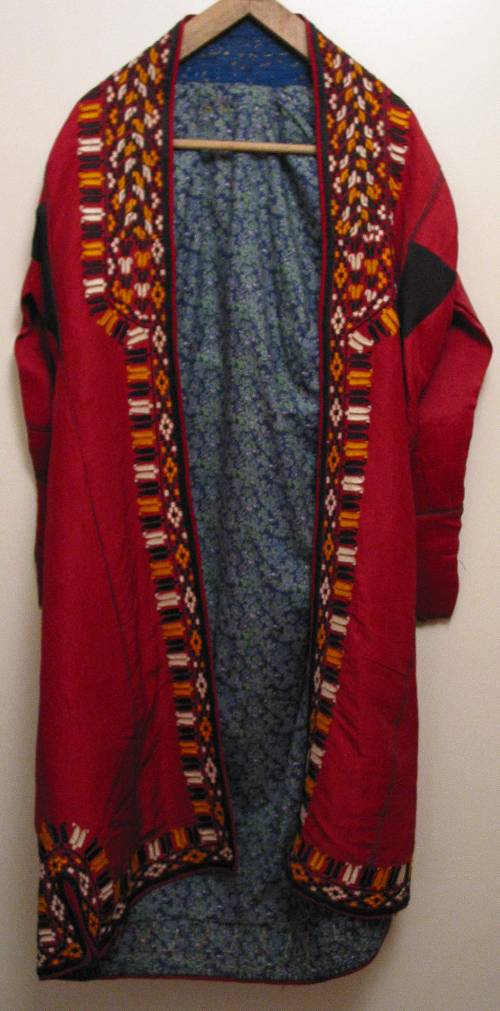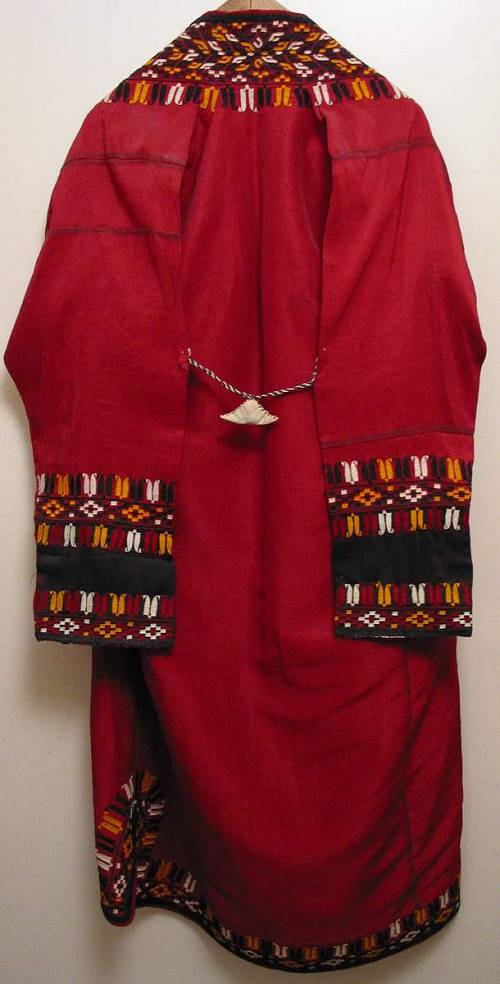Posted by Filiberto Boncompagni on 02-07-2006 01:04 PM:
Caucasian Wedding-dress
Dear all,
A bit out of topic for a forum on Oriental textiles, but not completely.
Meet my last ethnographic, Caucasian-related, acquisition.

This is a silk Wedding-dress, probably from the Lak village of Balkhar, Daghestan
( http://www.fallingrain.com/world/RS/17/Balkhar.html )
decorated with silver ornamentations inlayed with niello by Avar craftsmen,
late 19th century.
Actually what I just wrote is copied from the caption of the following plate:

from Tchirkov’s book “Daghestan Decorative Art”. It's so similar that I presume
it could apply to mine too.
It seems that the Daghestanis had the tradition of sewing these pendants, belt
buckles, earrings and other silver jewels, decorated also with silver coins,
corals, cornelians, turquoises and colored glass, on dresses for special occasions.
More views:



And a side view, showing one of the strange diminutive shaving-brushes sewn
under the junction of the sleeves.

Any idea of what they were for?
Have you seen anything similar to this dress? I’m referring particularly to
our Israeli participants. Here in Jordan I saw in the past several Daghestani
dresses decorated in the same way, but none as beautiful and complete as this.
Regards,
Filiberto
Posted by Steve Price on 02-07-2006 01:18 PM:
Hi Filiberto
That is a very cool garment.
The design in the region of the neck is vaguely reminiscent of those embroidered
on Nigerian men's robes known as agbada. Probably just a coincidence,
but it struck me as soon as I saw your photos.
I wonder whether the attachments are put there to distract the evil eye (malocchio
in the languages of the Caucasus  )
)
Distracting the evil eye is said to be an important function of various brightly
colored motifs on textiles and adornments throughout western and central Asia,
and figures prominently in embroideries from Daghestan.
Regards
Steve Price
Posted by R. John Howe on 02-07-2006 08:35 PM:
Filiberto -
I like the "dress." The jewelry resembles some Turkmen pieces.
If this is a wedding dress, it might be good to put up in this thread the one
image I think we have of a Caucasian wedding yurt.

Christoph Huber offered this once when we were talking about Turkmen engsis.
Probably from a different area. Christoph estimated it to be a North-Caucasian
Nogaian wedding-yurt.
Regards,
R. John Howe
A pretty dramatic door.
Posted by Dave Roberts on 02-07-2006 08:52 PM:
Those shaving brushes look like cosmetic applicators. The red stuff - rouge?
Just a guess but your wife or gf should agree.
DR

__________________
Dave
Posted by Chuck Wagner on 02-07-2006 09:11 PM:
Hi Filiberto,
I think we need to develop a new smiley for "amicably envious". Congratulations
on a really interesting find.
As you noted in your post, it's the quality of the work that makes this item
stand out. I think I see some nice niello work on several of those amulets,
which remided me of a belt we bought some time ago that was described by the
seller as Persian.
However, there is a Cyrillic hallmark on the back of the belt tip and I have
always wondered if it is actually Caucasian or Russian. I have little knowledge
of old Persian and/or Caucasian silver, and have found very few references.
From the "for-what-it's-worth" department, here are a couple images of the belt.
Also, a picture (from about 20 years ago) of a couple 20th century Central Asian
chapans with lots of metal. Note the plethora of triangular amulets on the one
at the right of the image.



Mabrook on the dress,
Chuck
__________________
Chuck Wagner
Posted by Don Ruyle on 02-08-2006 12:54 AM:
Don Ruyle
Hello Filiberto:
That looks like some Find! But looks like a storage and
display nightmare. It's hard enough to do the dusting.
But looks like a storage and
display nightmare. It's hard enough to do the dusting.
Regards,
Don
__________________
Don Ruyle
Posted by Filiberto Boncompagni on 02-08-2006 05:37 AM:
Thanks guys,
Steve,
Nigerian?!
About the malocchio as we say in Caucasian Italy, it could be an explanation.
Surely the Muskas, the triangular ornaments, are talismans against the
evil eye. We find their design on rugs too. Their origin is Turkmen, I think
- Asian for sure. It seems that also the coins have the function of enforcing
the anti evil eye effect.
But do not underestimate also the magical power of jewelry on the feminine psyche.

John,
Yes, the jewelry resembles some Turkmen pieces. The photo of the North-Caucasian
Nogaian wedding-yurt shows decorations in a very central Asian style. No wonder:
the Nogai were people of Turkic language; nomads separated from the Golden Horde
in the fourteenth century.
Dave,
I don’t know what is the red color. Henna, perhaps. But I don’t think they used
henna in Caucasus.
Chuck,
Nice belt. If it has Cyrillic hallmark it’s not Persian. It could be either
Russian in Caucasian stile or Caucasian.
IMHO it’s Russian, for the following reasons: the style of the niello is more
bold and rounded of the Daghestani one, I never saw this style of belt, and
the back of the Caucasian belt tips are generally less decorated than the front.
On the other hand it could be also from another area, like Georgia or Azerbaijan,
though. I have no knowledge of their styles.
To give you an idea, this is my Daghestani belt collection – the top and bottom
left are men’s belts:

And these are examples of Russian hallmarks. I have found some of them on my
collection:
Typical Moscow marks up to 1896:

Marks for 1896-1908

Marks for 1908-1917

Don,
You are right. Yesterday I had to store the dress, after it spent two weeks
on a sofa.
I cannot hang it, either for the dust – this is a very dusty country – and because
the ornaments are too heavy, and I’m afraid they will damage the fabric with
the time.
I have to find or build a horizontal display, like a table with a drawer and
a glass top.
Or a Plexiglas box with legs.
Regards,
Filiberto
Posted by Louis_dubreuil on 02-08-2006 08:08 AM:
amulettes et porte bonheur
Bonjour Filiberto
Nice dress, well preserved from any negative influence as evil, bad eye and
so on.
There is a good book that Sheila Paine wrote recently on this subject. I'll
send you bibliographic datas about it.
I have a turkmen dress with non functional sleeves. These sleeves are closed
and attached in the back with threads joining a tiny triangular material bag
in which there are, I suppose, some magical herbs. I'll send you pictures of
it.
Amicales salutations
Louis
Posted by louis_dubreuil on 02-08-2006 08:25 AM:
amulets
Here are the datas on the book
author : Sheila Paine
isbn : 1594770255
title : AMULETS,SACRED CHARMS OF POWER AND PROTECTION
Several years ago she had made a book about embroidered textiles (interesting,
in spite of a severe critic in Hali !)
An other book on this subject (I have not seen it yet, but amazon recommanded
it to me !).
author : Barbara Black Koltuv
title : AMULETS, TALISMANS AND MAGICAL JEWELLERY
Bonne journée
louis
Posted by Filiberto Boncompagni on 02-08-2006 08:31 AM:
Thank you Louis,
I should learn on the subject, it could be useful (one never knows)...
Regards,
Filiberto
Posted by Steve Price on 02-08-2006 01:19 PM:
Re: amulettes et porte bonheur
quote:
Originally posted by Louis_dubreuil
I have a turkmen dress with non functional sleeves. These sleeves are closed
and attached in the back with threads joining a tiny triangular material bag
in which there are, I suppose, some magical herbs.
Louis
Hi Louis
I'm wondering whether whether the garment to which you refer is actually a chyrpy
- a mantle worn by women, with false sleeves. You can see some chyrpy pictures here.
Regards
Steve Price
Posted by Chuck Wagner on 02-08-2006 09:21 PM:
A Hallmark Moment
Hi Filiberto,
You appear to have some resources available to you that have fairly specific
info on hallmarks. So, if you don't mind, would you take a look at this and
see if the MA mark appears in your material ?

Thanx,
Chuck
__________________
Chuck Wagner
Posted by Filiberto Boncompagni on 02-09-2006 02:03 AM:
Hi Chuck,
Here you can find a lot of stuff. I hope it can help.
Regards from a snowy Amman, 
Filiberto
Posted by louis_dubreuil on 02-09-2006 02:54 AM:
Chypry
Bonjour Filiberto
Here are, as promised , pictures of the Chypry (turkmen wedding dess) with false
sleeves attached with an amuletic device.



Uzbeks also use this type of cloth with false sleeves. This is the Parandja,
a kind of mantle the women put over their dress for visiting friends. There
is all of a ceremonial attached with the use of this cloth, with forbidden uses.



Meilleures salutations à tous
Posted by Filiberto Boncompagni on 02-09-2006 07:44 AM:
The missing parandja images are now in Louis’s post.
Filiberto






 )
)




 But looks like a storage and
display nightmare. It's hard enough to do the dusting.
But looks like a storage and
display nightmare. It's hard enough to do the dusting.










